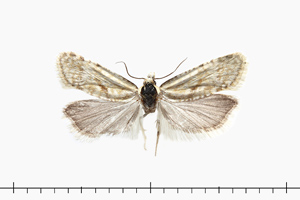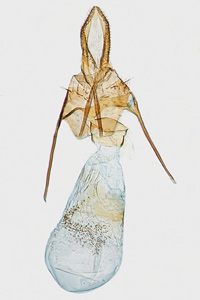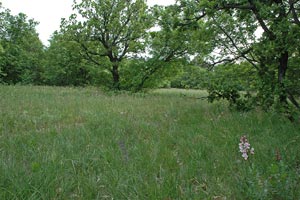2. Diagnose
2.1. Weibchen
2.2. Genitalien
2.2.1. Weibchen
3. Biologie
3.1. Habitat
3.2. Nahrung der Raupe
Noch unbekannt! Die Raupe ist in Blütenköpfen oder auch Stängelgallen einer oder mehrerer Centaurea-Arten zu vermuten.
(Autor: Erwin Rennwald)
4. Weitere Informationen
4.1. Andere Kombinationen
- Cochylis callosana Herrich-Schäffer, 1856 [Originalkombination]
- Euxanthis callosana (Herrich-Schäffer, 1856)
4.2. Taxonomie
Kovács et al. (2024) stellen fest, dass es sich bei den bisher unter Cochylimorpha perfusana gehandelten Tieren nicht um eine Einzelart, sondern eine Gruppe von vier verwandten Arten handelt. In ihrer Arbeit befreien sie Cochylis callosana Herrich-Schäffer, 1851 und Euxanthis dorsimaculana Preissecker, 1908 aus der Synonymie von C. perfusana und erklären sie zu guten Arten: Cochylimorpha callosana bzw. Cochylimorpha dorsimaculana. Hinzu kommt die Beschreibung von Cochylimorpha bucegiana als neue Art. Die 4 Arten sind beim Barcoding meist deutlich voneinander getrennt. Dies gilt auch für C. dorsimaculana, zu der Kovács et al. (2024: 154) schreiben: "The intraspecific divergence of the DNA barcode region is 0.15% (n = 2). The minimum distance to the nearest neighbour, C. dorsimacula na, is 3.12%, to C. perfusana 3.13%, to C. bucegiana sp. nov. 4.43%."
4.3. Faunistik
Die von Herrich-Schäffer (1856: 157) genannte Typenlokalität ist "Fiume", das heutige Rijeka in Kroatien. Kovács et al. (2024: 154-155) trugen zusammen: "Widespread in the north-western part of the Balkan Peninsula (Croatia and Slovenia) and north-eastern Italy, localized in eastern France (Prémanon), and known only from historic records from Corsica (France) and Hungary. The type locality is Rijeka (formerly Fiume) in north-western Croatia (Herrich-Schäffer 1856: 157). Razowski (1970: 162; 2002: 43; 2009: 37) erroneously gives Lower Austria: Schneeberg or only Austria as the type locality of the species, but these records refer to C. perfusana (Herrich-Schäffer 1851: 183). We examined voucher material from north-western Croatia (Rijeka; Velebit Mountains: Velebitski, Baške Oštarije, 1100 m; Istria: Mt. Maggiore), south-western Slovenia (Nanos; Senožeče; Kozina; Komen), north-eastern Italy (Trieste; Trentino; Friuli; Udine), Corsica and Hungary (Budapest, Csillebérc, as Jambory). These are the first country records for Slovenia and Hungary (for explanations see below). Further material was identified from figures in the literature or available on the world wide web (all as C. perfusana unless otherwise mentioned): Yugoslavia without further details (Razowski 1987: 250 figs 70–72, 313 figs 562–563 as Stenodes perfusana; 2001: 37; 2002: 43, pl. 5 fig. 91, pl. 47 fig. 91; 2009: 37, pl. 9 fig. 97, pl. 40 fig. 97); north-eastern Italy (Monte Bondone, Viotte, 1500 m; Val. Venzonassa, Malga Confin; Trieste, Basovizza, 440 m) (Klimesch 1951: 24; P. Huemer in BOLD and pers. comm.; R. Bryner in Lepiforum as Phalonidia acutana (Kennel, 1913)); Hungary (Budapest) (Fazekas 1994: 40 fig. 1); and the first record from mainland France (Prémanon, 26.v.2022) (G. Mainguy in iNaturalist)." Die Autoren vermerken, dass die Angabe von Kennel (1913) aus dem Wallis (Schweiz) wahrscheinlich nicht hierher sondern zu C. perfusana gehört.
4.4. Typenmaterial
Kovács et al. (2024: 152) schreiben zum von ihnen untersuchten Typenmaterial: "Type material examined. Cochylis callosana Herrich-Schäffer, 1856: Lectotype. ♂, Callosana HS.; H. – Sch.; Origin. [al]; loc. ?; ex coll. Staudinger 1/2; Zool. Mus. Berlin; MfN URI http://coll.mfn-berlin.de/u/09f9e3; MfN (Fig. 47). The images of the lectotype from the MfN are figured here courtesy and kind permission of Viola Richter. Paralectotype. ♂, Callosana HS.; H. – Sch.; Origin.[al]; loc. ?; ex coll. Staudinger 2/2; Zool. Mus. Berlin; MfN URI http://coll.mfn-berlin.de/u/09fb0a; MfN."
(Autor: Erwin Rennwald)
4.5. Literatur
- Kovács, Z, Kovács, S., Buchner, P. & J. Junnilainen (2024): A review of the Cochylimorpha perfusana (Guenée, 1845) species group (Lepidoptera, Tortricidae) in Europe, with the description of a new species from the Southern Carpathians (Romania). — Nota Lepidopterologica, 47: 125–162. [zum open-access-Artikel auf pensoft.net]
- Erstbeschreibung: Herrich-Schäffer, G. A. W. (1843-1856): Systematische Bearbeitung der Schmetterlinge von Europa, zugleich als Text, Revision und Supplement zu Jakob Hübner's Sammlung europäischer Schmetterlinge. Sechster und letzter Band: Schlusswort [4 pp., unpaginiert]; Macrolepidoptera I-XVIII, pl. I-XXII; Microlepidoptera I-VIII, pl. I-XIV; Nachtrag zum ersten Bande 1-38, Nachtrag zum zweiten Bande 39-61, Nachtrag zum dritten Bande 62-80, [Nachtrag ohne Titel] 81-133; Weitere Nachträge zum dritten Band 133-139, Nachträge zum vierten Band 140-161, Nachträge zum fünften Band 161-166, Zweiter Nachtrag zum ersten und zweiten Bande 167-178; Systema Lepidopterorum Europae 1-72; Index 1-48. Regensburg (G. J. Manz). [Digitalisat auf biodiversitylibrary.org]





![Vorkommen in Frankreich (europäisches Territorium ohne Korsika) [Prémanon]](/res/img/flag/fr.gif)



![Vorkommen in Kroatien [locus typicus: Rijeka]](/res/img/flag/hr.gif)




